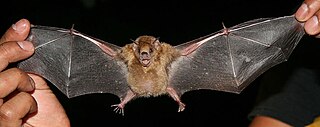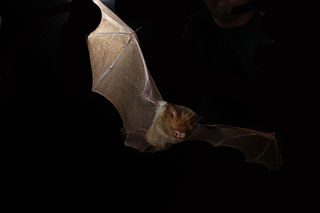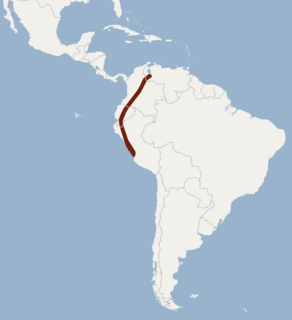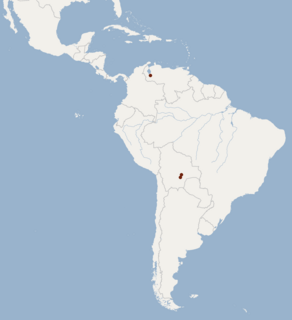
The New World leaf-nosed bats (Phyllostomidae) are found from southern North America to South America, specifically from the Southwest United States to northern Argentina. They are ecologically the most varied and diverse family within the order Chiroptera. Most species are insectivorous, but the phyllostomid bats include within their number true predatory species and frugivores. For example, the spectral bat, the largest bat in the Americas, eats vertebrate prey, including small, dove-sized birds. Members of this family have evolved to use food groups such as fruit, nectar, pollen, insects, frogs, other bats, and small vertebrates, and in the case of the vampire bats, even blood.

The white-winged vampire bat, a species of vampire bat, is the only member of the genus Diaemus. They are found from Mexico to northern Argentina and are present on the islands of Trinidad and Margarita.

Wagner's mustached bat is a bat species from South and Central America. It is one of the few New World bats species known to perform Doppler shift compensation behavior.

The broad-eared bat or broad-tailed bat is a species of free-tailed bat from the Americas.

The little white-shouldered bat is a species of bat from South and Central America. It is the only species within its genus, the name of which translates as "reaper" or "destroyer".

The tailed tailless bat is a species of leaf-nosed bat from South America.

The Brazilian big-eyed bat is a species of phyllostomid bat from South America. The scientific name honours Italian naturalist Giacomo Doria.

The pale spear-nosed bat is a species of phyllostomid bat from South and Central America.

The little yellow-shouldered bat is a bat species from South and Central America. This species is a frugivore and an effective seed disperser. It roosts alone in tree cavities, on branches, vines, and under palm leaves, usually keeping to the same roosts day to day. There is evidence to suggest hypothermia is a thermoregulatory strategy to help adjust metabolic levels. In terms of mating, ambient temperature has been noted as a greater influence as compared to food availability. Its wing shape can also be affected by pregnancy in order to make flight more efficient.

The Chilean myotis is a species of vesper bat found in southern South America.

The diadem leaf-nosed bat or diadem roundleaf bat is one of the most widespread species of bat in the family Hipposideridae. It is probably most closely related to Hipposideros demissus from Makira and to Hipposideros inornatus from the Northern Territory in Australia. Hipposideros diadema is found in Australia, Indonesia, Malaysia, Myanmar, the Philippines, Thailand, and Vietnam.

Sturnira known as a yellow-shouldered bat or American epauleted bat, is a genus of bat in the family Phyllostomidae. The genus name comes from the Latin for "starling" and refers to HMS Starling, which took part in an 1836 voyage to Brazil during which the type specimen was collected. It contains the following species:

The Bogotá yellow-shouldered bat is a species of bat in the family Phyllostomidae. It is found in Colombia, Ecuador, Peru, and Venezuela at altitudes from 300 m to above 2000 m, particularly in cloud forest. The species is primarily frugivorous; it may also consume nectar and pollen.

The Talamancan yellow-shouldered bat is a species of bat in the family Phyllostomidae. It is found only in Costa Rica and Panama, and there are no subspecies.

The lesser yellow-shouldered bat is a species of bat in the family Phyllostomidae. It is native to Peru and Ecuador. It is threatened by habitat loss.

Stenodermatinae is a large subfamily of bats in the family Phyllostomidae.

Tschudi's yellow-shouldered bat is a species of leaf-nosed bat indigenous to Argentina, Ecuador, and Peru, with its range also encompassing Bolivia.

Soriano's yellow-shouldered bat, is an extant species of leaf-nosed bat indigenous to Bolivia and Venezuela, although its precise distribution is uncertain. Following the postulation of the species in 2005, S. sorianoi requires contemporary information relating its distribution, environment, and population, along with formal a comparison with S. erythromos and S. bogotensis. Without sufficient data, the International Union for Conservation of Nature (IUCN) presently considers the taxonomy for S. sorianoi as incomplete.

The cinnamon red bat is a species of bat in the family Vespertilionidae. It was first described from a specimen that had been collected in Chile. For more than one hundred years after its initial description, it was largely considered a synonym of the eastern red bat. From the 1980s onward, it was frequently recognized as distinct from the eastern red bat due to its fur coloration and differences in range. It has deep red fur, lacking white "frosting" on the tips of individual hairs seen in other members of Lasiurus. It has a forearm length of 39–42 mm (1.5–1.7 in) and a weight of 9.5–11.0 g (0.34–0.39 oz).



















